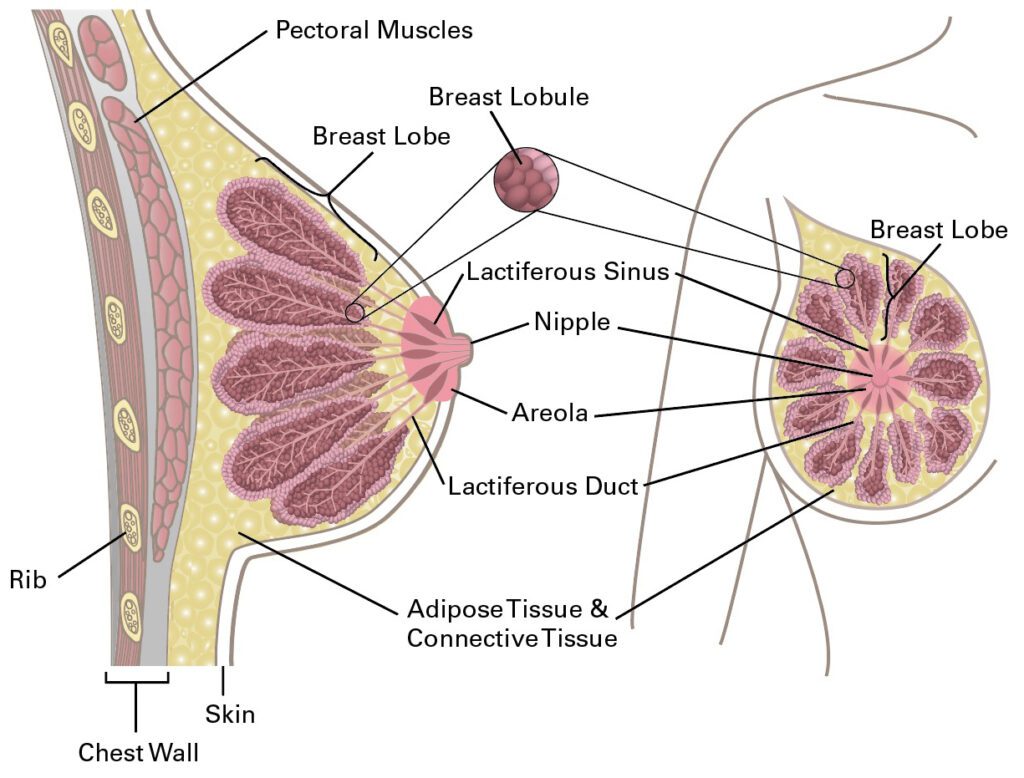Breast Anatomy
The breast is composed of skin and subcutaneous tissues, mammary gland, breast ducts (milk ducts), adipose tissues and connective fibrous tissues. The mammary gland is the major component of the breast, and is composed of 15-20 breast lobes. Each breast lobe is further divided into multiple breast lobules. Even for the same person, the amount of tissues on both breasts can be different, so the breasts are not necessarily identical on both sides.
Breast milk is produced in breast lobules, which gathers in the ductules within the lobules, then flows into ducts of the breast lobes, via the lactiferous ducts, and eventually passes into lactiferous sinuses just beneath the areola that opens towards the nipple.

The Blood and Lymphatic System of the Breast
The breast has a very rich and intricate blood and lymphatic system. The blood supply mainly comes from the internal mammary artery and the lateral thoracic artery; and to a lesser extent from branches of the thoracic artery, the intercostal artery and the dorsal thoracic artery.
The lymphatic system of the breast is composed of lymphatic channels and lymph nodes. Lymphatic fluid (or lymph) flows along the channels throughout the breast with lymph nodes as stations in between the system. These lymph nodes help to filter out bacteria, viruses, cancer cells, or other body metabolites as the lymph passes through. After the lymph has transited across the breast, it drains away through several lymphatic systems. The majority goes to the subdermal lymphatic plexus, then into the axillary lymph nodes; some goes through the intra-thoracic and the inter-thoracic lymph nodes; and finally all returns to the main venous circulation system.
Breast cancer most often spreads to the axillary lymph nodes first (the lymph nodes in the armpit regions). Thus, whether these lymph nodes contain cancer cells is one of the most important factors in the staging of breast cancer. It is also a crucial factor in determining the patient’s treatment and surgical plan.
Normal Growth of the Breast
The function and growth of the breast are regulated and influenced by various hormones, namely estrogen, progesterone, prolactin, oxytocin and growth hormones. Estrogen stimulates the development of breast ducts, and progesterone promotes the growth of breast lobes. During pregnancy, progesterone further helps the enlargement of breast lobules and causes the ducts to dilate. Prolactin stimulates milk production and helps maintain lactation. Milk is discharged from the nipple to feed the baby.
Abnormal Growth of the Breast
Under normal circumstances, breast cells divide and reproduce in an orderly manner just like any other cells in the body. However, in certain situations, these cells begin to multiply uncontrollably, thus accumulate into breast lumps, commonly known as breast tumours or breast masses. Breast tumours can be divided into benign (non-cancerous) or malignant (cancerous). In fact, most breast tumours are benign. Malignant breast tumours are what we called breast cancers. Apart from increasing age, the formation of breast tumors and breast cancers is mostly related to hormones.





